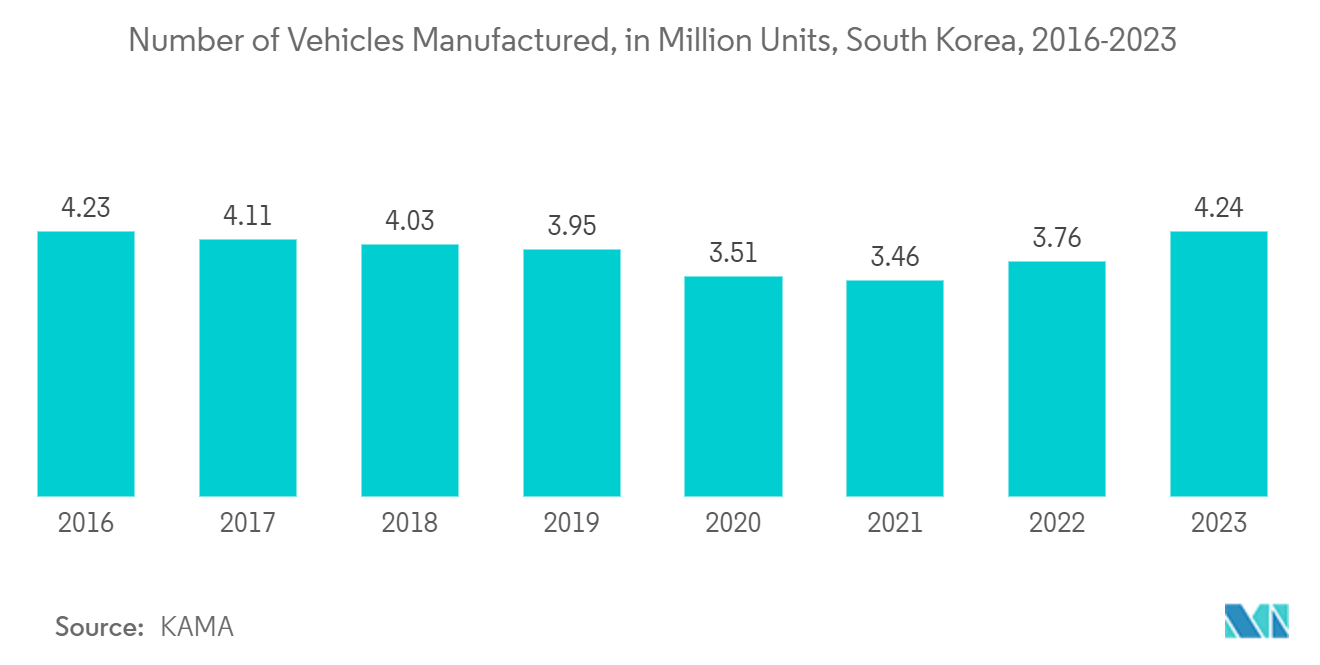Market Trends of South Korea Optoelectronics Industry
The Image Sensors Segment is Anticipated to Drive the Demand for the Studied Market
- Image sensors are a crucial component in optoelectronics that allows cameras and imaging devices to convert photons into electrical signals that can be interpreted and processed. The first digital cameras used charge-coupled devices (CCDs) to facilitate the movement of electrical charge through the device for modulation. However, modern cameras predominantly use complementary metal-oxide-semiconductor (CMOS) sensors due to their low power consumption, high integration, and compatibility with standard CMOS fabrication processes.
- The emergence of 3D imaging technologies has opened new avenues for image sensors. Applications in augmented and virtual reality are growing, especially in gaming and entertainment, where South Korea has a significant market presence. The integration of depth-sensing capabilities in mobile devices is also driving demand.
- Incorporating artificial intelligence in image processing has enhanced the functionality of image sensors. AI algorithms improve image quality, enable facial recognition, and facilitate various applications in security and surveillance, further expanding the market.
- Further, the consumer electronics sector is a major contributor to the growth of the image sensor market in South Korea. As consumers increasingly prioritize advanced camera technology in their devices, manufacturers are compelled to innovate and enhance their offerings. South Korea is home to major smartphone manufacturers, such as Samsung and LG, who are continuously pushing the envelope regarding camera technology. The demand for multi-camera setups and features like optical zoom and night mode has propelled the need for advanced image sensors.
- Modern manufacturing and logistics distribution centers must increase productivity by increasing conveyor speeds and widening fields of view and working ranges. New CMOS image sensors are emerging onto the market studied and designed especially for scanning applications, representing a significant step forward in industrial applications, thus boosting the growth of the CMOS sensor image market. Robots equipped with CMOS image sensors can inspect and identify components, exactly measure dimensions, or monitor machines or other robots during pick-and-place and assembly operations.
- According to the Bank of Korea, in 2023, South Korea's gross domestic product (GDP) increased by 1.4% year-on-year, while the manufacturing sector grew by roughly 1%. The manufacturing sector makes up a large part of the South Korean economy and has helped South Korea achieve rapid economic growth over the past decades. The robust manufacturing sector in South Korea is highly anticipated to aid the growth of the market studied.

The Automotive Sector is Anticipated to Hold a Major Market Share
- One of the most prominent applications of optoelectronics in the automotive sector is lighting systems. Traditional incandescent lights are being replaced by LED (Light Emitting Diode) technology, which offers better energy efficiency, longer lifespan, and improved brightness. South Korean automotive manufacturers like Hyundai and Kia are increasingly adopting LED technology for headlights, taillights, and interior lighting. Additionally, advanced lighting systems such as Adaptive Front Lighting Systems (AFS) and matrix LED headlights enhance driving safety by automatically adjusting the light distribution based on driving conditions.
- Vehicle displays, including instrument clusters, infotainment systems, and heads-up displays (HUDs), utilize optoelectronic technologies such as LCD (Liquid Crystal Display) and OLED (Organic Light Emitting Diode) screens. These displays help drivers with real-time information, navigation, and entertainment. South Korea's automotive companies are integrating more sophisticated displays into their vehicles to enhance user experience and connectivity.
- The increasing automotive manufacturing is likely to aid the growth of the market studied . For instance, according to the Korea Automobile Manufacturers Association (KAMA), in 2023, approximately 4.24 million units of vehicles were manufactured in South Korea. This increased from nearly 3.76 million units in the previous year, the highest figure recorded since 2015.
- With the upsurge in demand for electric vehicles worldwide and government support to improve domestic manufacturing, South Korean Automakers such as Hyundai, Kia, and Genesis are focusing on increasing production volume and investing heavily in development and manufacturing.
- In March 2024, Hyundai Motor Group announced that it would invest USD 51 billion over three years in South Korea to ramp up electric vehicle production and new mobility business and separately hire 80,000 new employees, doubling down at a time when other established automakers are slowing efforts.
- The push toward autonomous vehicles is a major driver of optoelectronic applications in the automotive industry. Technologies such as LIDAR and camera systems are essential for enabling vehicle autonomy. South Korean companies, including established automakers and startups, are heavily investing in research and development to advance these technologies, thus fueling market growth.


